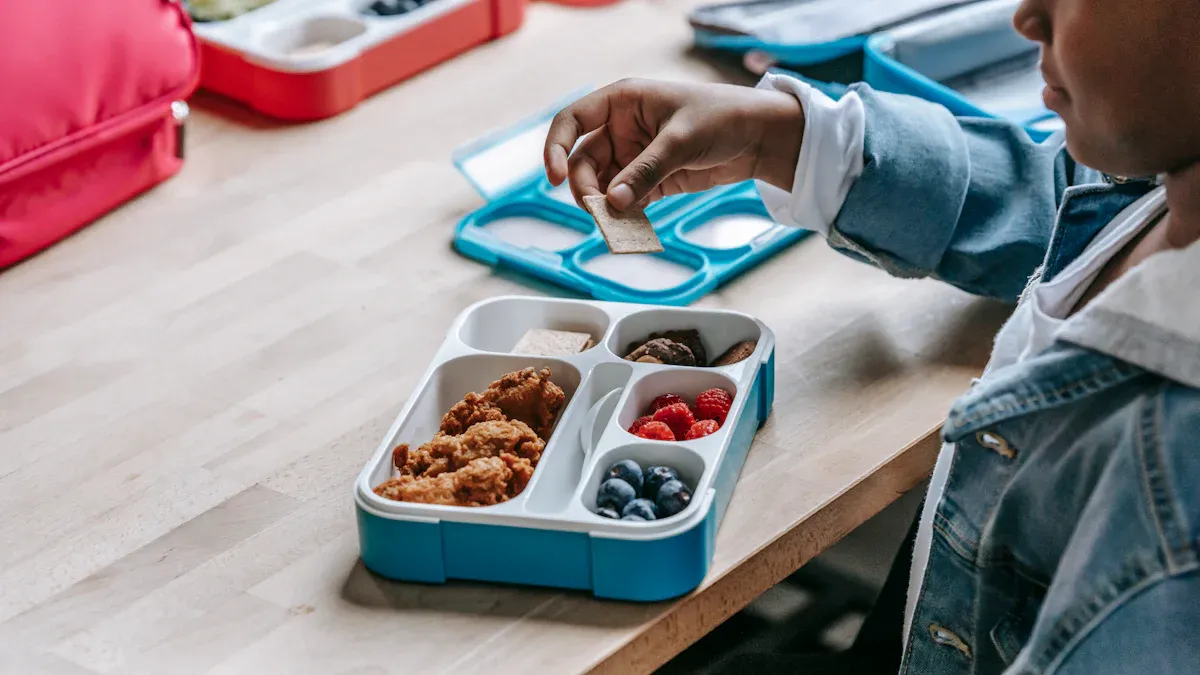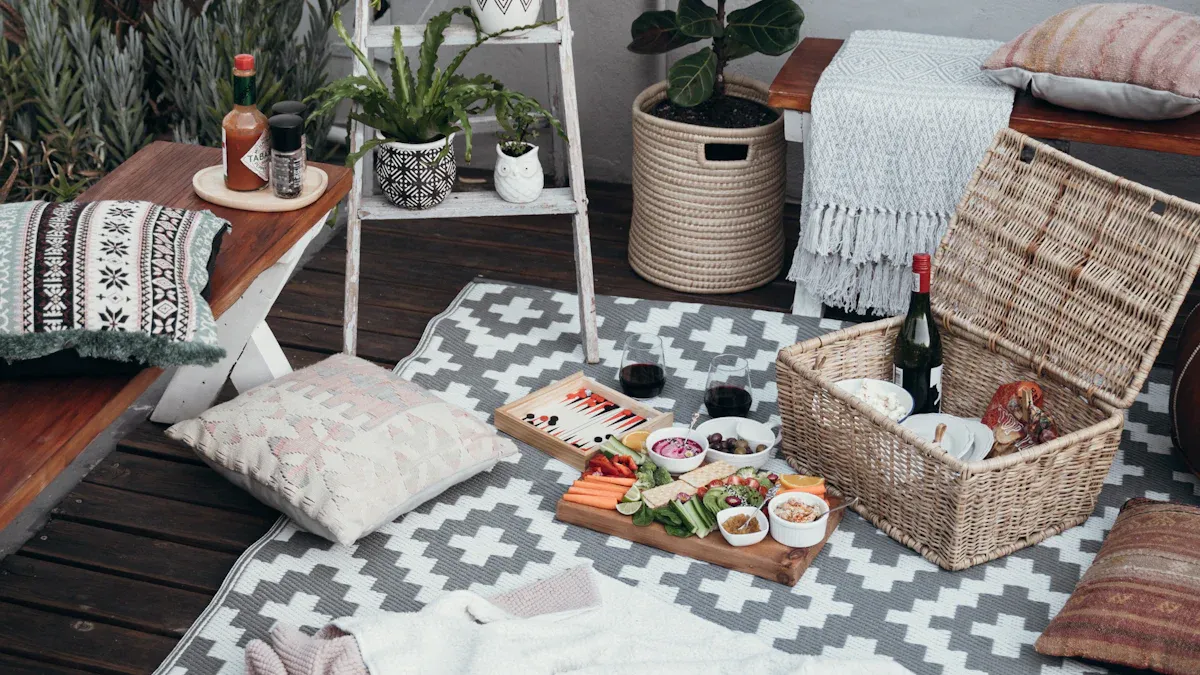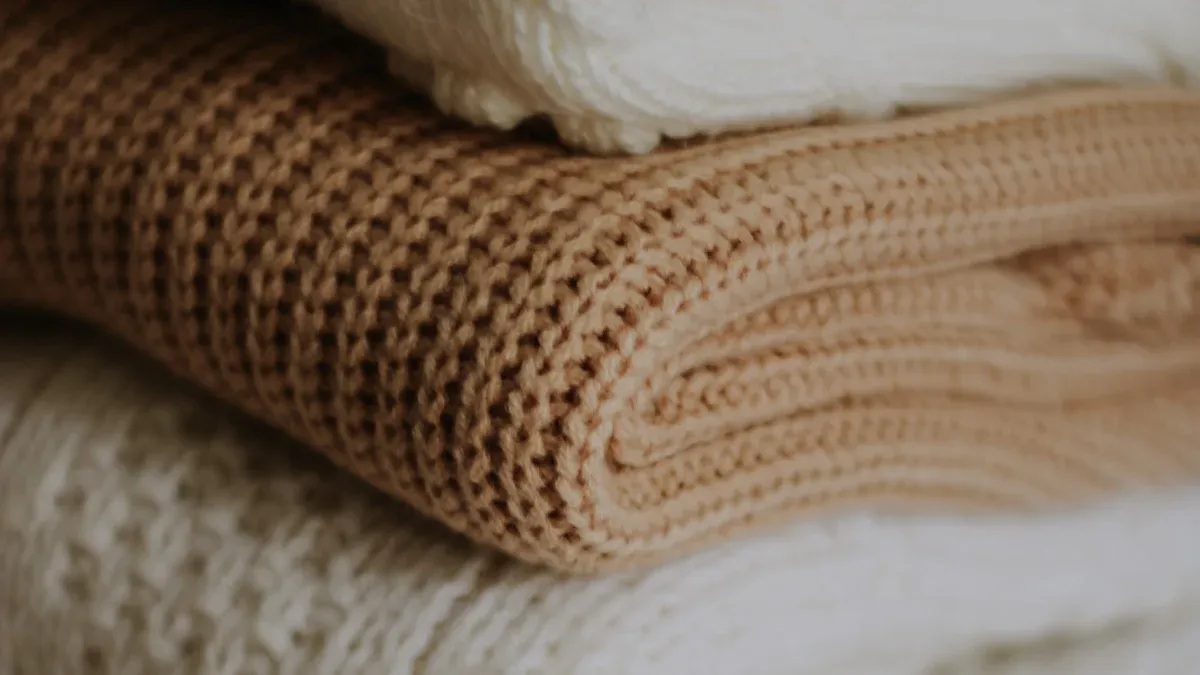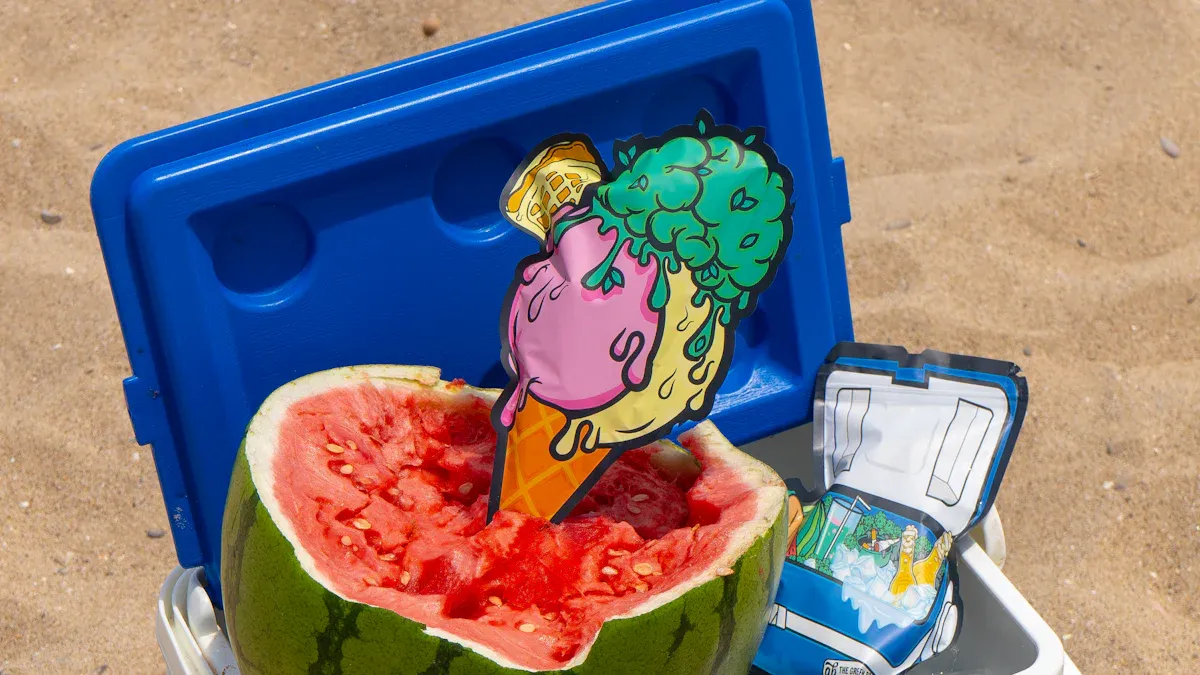

An excellent woven cooler bag, like those from KUER, has a smart design. It uses three main layers. These layers include a tough outer shell, a core for insulation, and a waterproof inner liner. The specific cooler bag material chosen for each layer is very important. This choice affects the cooler’s performance, how long the bags last, and their price. The importance of material selection cannot be overstated for quality cooler bags. The right materials ensure your cooler keeps items cold. These bags rely on a combination of different materials, with each material playing a crucial role in the overall function and insulation of the woven cooler bag.
Key Takeaways
- A good cooler bag has three main parts: a strong outside, insulation to keep things cold, and a waterproof inside.
- The outside of the cooler bag needs tough materials like polyester or nylon with a water-resistant coating to protect it.
- The middle layer uses foam, especially PU foam, and reflective foil to keep your food and drinks cold for a long time.
- The inside lining must be waterproof and safe for food, using materials like PEVA or TPU, and should have welded seams to prevent leaks.
- Knowing about these materials helps you choose a cooler bag that works best and lasts longer.
The Exterior Shell: Choosing the Best Cooler Bag Material for Durability

The exterior shell of a cooler is its first line of defense against the elements. This layer must be tough enough to handle scrapes, sun, and moisture. The best cooler bag material for the shell is both durable and lightweight. High-quality materials ensure the cooler bags last for many seasons. Manufacturers often choose specific fabrics and coatings to achieve the perfect balance of strength and protection for their bags.
Common Fabrics: Polyester vs. Nylon
Polyester and nylon are the two most common fabrics for the exterior of a woven cooler bag. Both materials are lightweight and offer good resistance to abrasion and UV rays. This makes them an excellent cooler bag material. Nylon is generally a stronger material than polyester. A blend of these materials often creates a fabric that is lightweight yet strong. The choice between them affects the cooler’s overall durability and quality.
| Property | Test Standard | Typical Range (80/20 Polyester-Nylon Blend) |
|---|---|---|
| Tensile Strength (N) | ASTM D5034 | 700–900 |
| Tear Strength (N) | ASTM D1424 | 20–30 |
Adding nylon to polyester can boost tensile strength by about 15%, creating a cooler bag material that is lightweight yet strong. This makes the bags more resilient for outdoor adventures.
Water-Resistant Coatings: PU vs. PVC
The fabric shell needs a coating to become water-resistant. Polyurethane (PU) and Polyvinyl Chloride (PVC) are two popular choices. A water-resistant coating is essential for protecting the cooler insulation. While PVC offers a higher waterproof rating, PU provides better long-term durability and flexibility, making it the best material for cooler bags focused on quality.
| Coating Type | Waterproof Rating (mm) |
|---|---|
| Single PU layer | 1,000–3,000 |
| Double PU layer | 3,000–5,000 |
| PVC coating | 10,000–30,000 |
PU coatings are more resistant to cracking and peeling over time, especially in the sun. This makes the cooler more reliable.
| Feature | PU Coatings | PVC Coatings |
|---|---|---|
| Cracking Resistance | More resistant to cracking | Prone to cracking over time |
| Peeling Resistance | Less prone to peel | Can peel in high heat/humidity |
Furthermore, there is a growing focus on eco-friendly materials. PVC has faced scrutiny from regulatory bodies. This makes PU a more eco-friendly choice for custom cooler bags and other consumer goods.
- The U.S. EPA has proposed designating vinyl chloride (used to make PVC) a high-priority chemical.
- Several states have introduced bills to restrict PVC in packaging.
- Major companies like Apple, IKEA, and Nike have policies to phase out PVC.
This shift toward an eco-friendly cooler bag material makes PU a forward-thinking choice for quality cooler bags.
Ultimately, a water-resistant PU coating on a durable fabric creates a superior exterior for any cooler. These water-resistant bags are built to perform.
The Insulation Core: The Key Cooler Bag Material for Temperature Control

The insulation core is the heart of any cooler. This layer does the heavy lifting to keep contents cold. The choice of cooler bag material for the insulation directly impacts how long ice lasts and how fresh food stays. Effective insulation works by slowing down heat transfer. Manufacturers use specific insulation materials to achieve the best thermal efficiency. The right material is key for high-performing cooler bags.
Foam Types: PE, XPE, and PU Foam
Foam is the most common cooler bag material for insulation. The three main types are Polyethylene (PE), Cross-linked Polyethylene (XPE), and Polyurethane (PU) foam. Each material offers different levels of insulation. The R-value measures a material’s ability to resist heat flow. A higher R-value means better insulation.
| Material | R-Value per Inch |
|---|---|
| PE Foam | 1.5 |
| XPE Foam | 2.0 |
| PU Foam | 3.5 |
PU foam provides the highest R-value, making it a superior choice for foam insulation. The density of these insulation materials also affects the cooler’s durability. Denser foams resist being crushed. A material’s ability to bounce back after being compressed is called its compression set. A low compression set means the foam insulation will maintain its thickness and efficiency over time, which is vital for the long-term performance of cooler bags. PU foam insulation shows excellent resistance to compression.
| Foam Type | Density (lb) | Compression Set % |
|---|---|---|
| PE | 2 | Not Specified |
| XPE | 12 | Not Specified |
| PU | 8–23 | 3 max |
The Role of Reflective Foil
Many high-quality cooler bags include a reflective foil layer. This layer works with the foam to boost the cooling efficiency of cooler bags. The foil’s main job is to fight radiant heat.
- Reflective materials, like aluminum, act as a barrier to radiant heat.
- They reflect heat waves away from the cooler’s contents.
- This simple feature can increase insulation efficiency by up to 15%.
- This process helps maintain a stable temperature inside the bags.
Think of the foil as a mirror for heat. It bounces heat away from your food and drinks, helping the foam insulation do its job even better.
This combination of foam and foil creates a system for effective insulation. It ensures the cooler provides maximum performance. These insulation materials are the best cooler bag material for keeping things cold. The right insulation is what makes a good cooler.
The Inner Lining: Waterproof and Food-Safe Materials
The inner liner is the final, critical layer of a cooler. This layer directly touches your food and drinks. It must be waterproof, easy to clean, and safe for food contact. The choice of cooler bag material for the liner affects the cooler’s leak resistance and overall quality. A great cooler uses a durable, food-grade material for its liner.
Liner Materials: PEVA vs. TPU
Manufacturers commonly use two materials for the inner liner: Polyethylene Vinyl Acetate (PEVA) and Thermoplastic Polyurethane (TPU). Both are excellent choices for a modern cooler. They are lightweight and safe for food. These materials are certified as BPA-free and phthalate-free. This makes them a responsible choice for custom cooler bags. PEVA is a popular, eco-friendly material. It is a PVC-free, lightweight material known for being tear-resistant.
For a cooler to be truly food-safe, its materials must meet strict standards.
- High-quality cooler bags feature FDA-compliant materials.
- Top-tier products also meet EU and ISO standards for food-grade applications.
While both materials offer good quality, TPU provides superior performance. It is an extremely durable and flexible material. This quality is important for a long-lasting cooler. A TPU liner remains supple even in very cold temperatures. This prevents the material from cracking.
| Feature | PEVA | TPU |
|---|---|---|
| Flexibility | Fair; can become stiff | Excellent; stays flexible down to –30 °C |
| Cold-Cracking Temperature | Prone to stiffness in cold | –30 °C (maintains suppleness) |
TPU’s durability makes it the premium cooler bag material for a high-performance cooler. This lightweight material ensures the cooler can handle frequent use.
Seam Construction: Welded vs. Stitched
The construction of the liner seams determines if a cooler is truly leak-proof. Stitched seams create tiny holes from the needle. Water can easily leak through these holes. Welded seams, on the other hand, use heat or radio frequencies to fuse the material together. This process creates a single, continuous piece of material.
A welded seam is like a locked door for water—nothing gets through. A stitched seam is more like a screen door.
Welded seams are significantly stronger than stitched seams. This strength prevents the liner from tearing when the cooler is full. The superior quality of welded seams makes them essential for any reliable cooler. This construction ensures your cooler bags will not leak.
| Method | Strength (lbs/in) |
|---|---|
| Welded | 50–80 |
| Sewn | 20–40 |
A waterproof, eco-friendly liner with welded seams is the hallmark of a premium cooler. This combination guarantees a clean, dry, and safe experience for every outing.
A superior woven cooler bag combines three layers. Each material works together for top cooler performance. This cooler design uses specific materials. A tough exterior, effective insulation, and a waterproof liner create a high-quality cooler. This construction keeps the cooler contents cold. Knowledge of each cooler material helps users choose the best cooler. This understanding is key for selecting the right cooler bags, including custom cooler bags. The right insulation material makes a better cooler. A great cooler depends on its material. A KUER woven cooler bag is an excellent cooler.
FAQ
What makes a cooler bag leak-proof?
A truly leak-proof cooler uses welded seams in its inner liner. This construction method fuses the material together. It creates a single, continuous barrier that prevents any water from escaping. Stitched seams, in contrast, have small holes that can allow leaks.
How should I clean my woven cooler?
Users should clean the inner liner of the cooler with mild soap and warm water. A soft cloth or sponge works best. Always rinse the liner thoroughly. Let the bag air dry completely with the lid open to prevent moisture buildup.
Why is the outer fabric of a cooler important?
The outer fabric protects the cooler from damage. Durable materials like polyester and nylon resist scrapes and tears. A water-resistant coating on the fabric also shields the insulation from moisture, which helps maintain the cooler’s performance and extends its lifespan.
Which insulation material is best for a soft cooler?
Polyurethane (PU) foam offers the best insulation for a soft cooler. It has a higher R-value than other foams. This means it resists heat transfer more effectively. A cooler with PU foam will keep its contents cold for a longer period.
Are the materials inside a cooler safe for food?
Yes, high-quality cooler bags use food-safe materials for the inner liner. Liners made from PEVA or TPU are BPA-free and phthalate-free. These materials meet strict safety standards, ensuring they are safe for direct contact with food and drinks.




